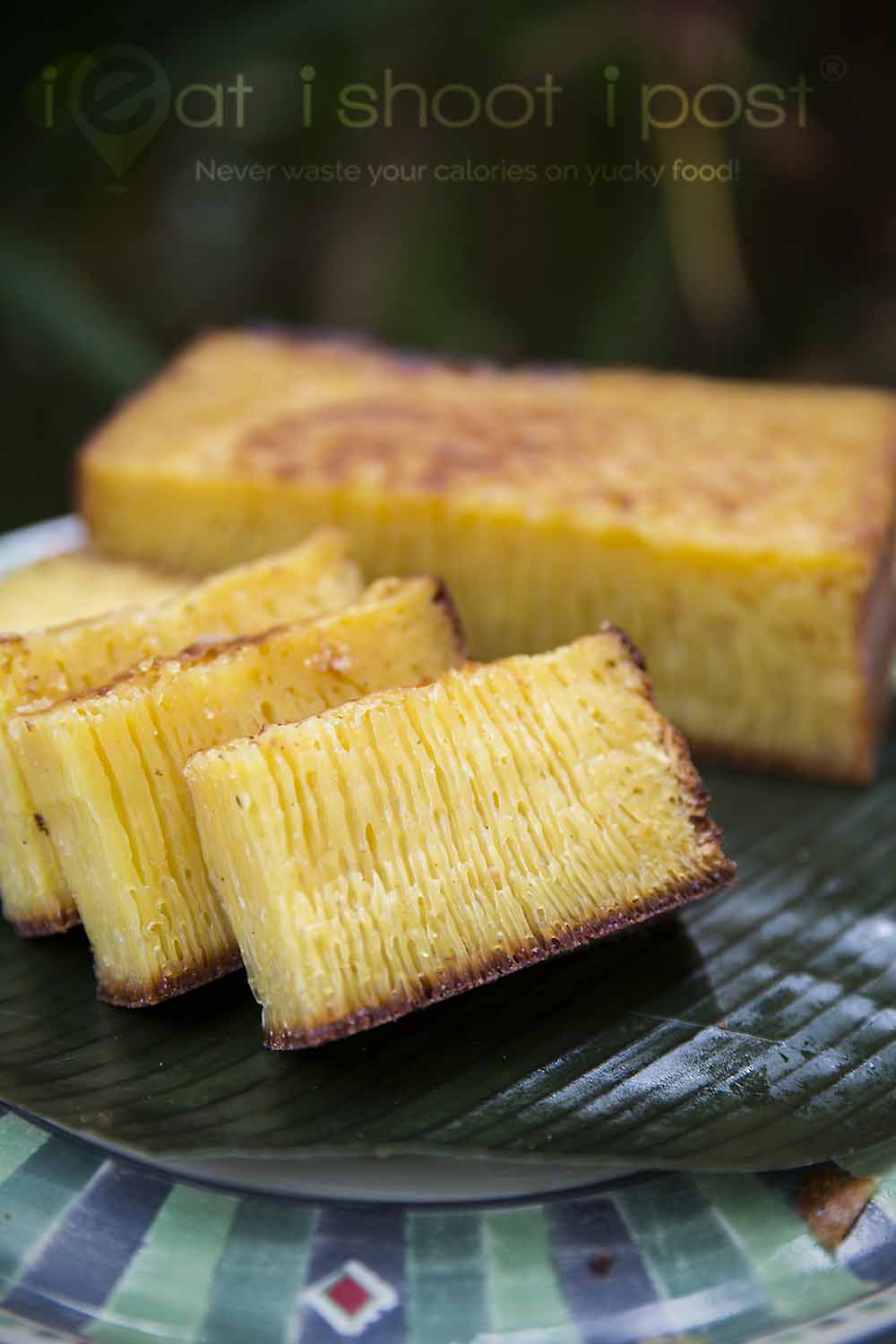
I don’t know what got me started on this Kueh Bingka/Bika Ambon recipe, but my first attempt was in April this year where I used a recipe from Mrs Leong Yee Soo’s cookbook. You can see the disastrous results below. (Main photo) To be fair, I don’t think it is a problem with her recipe, it just didn’t contain enough details for a newbie like me to achieve the perfect result. But it did get me intrigued. Up till then I haven’t even eaten the original Kuih Bingka Ambon from Medan, but I knew that what I baked was no where close to the real thing.

I consulted Christopher Tan’s Nerdbaker cookbook and was surprised that he didn’t have a recipe for this though there was a photo of it in his book. When I asked him about it, he told me that this was one of the most difficult kuihs to get right and he wasn’t 100% happy with his own recipe yet. That gave me the impetus to master this confounding confectionery. There really isn’t much incentive in publishing a recipe that every internet cook already knows. But to publish a recipe that many regard as really difficult, now, that is a challenge!
There are many recipes online and I have probably looked through all of them, including the ones in Indonesian. None of them have all the information you need in order to create a kuih that looks like the one in this photo. In this post, I will share with you everything that I have learnt through the numerous attempts at making this enigmatic cake.
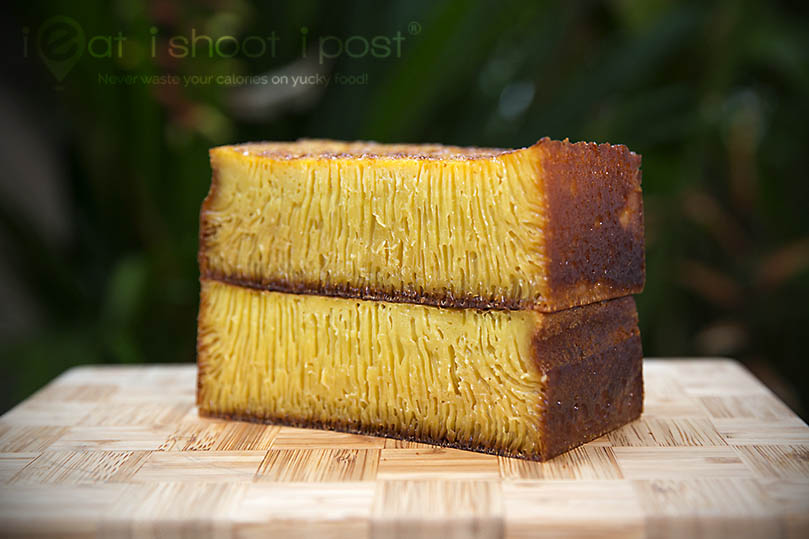
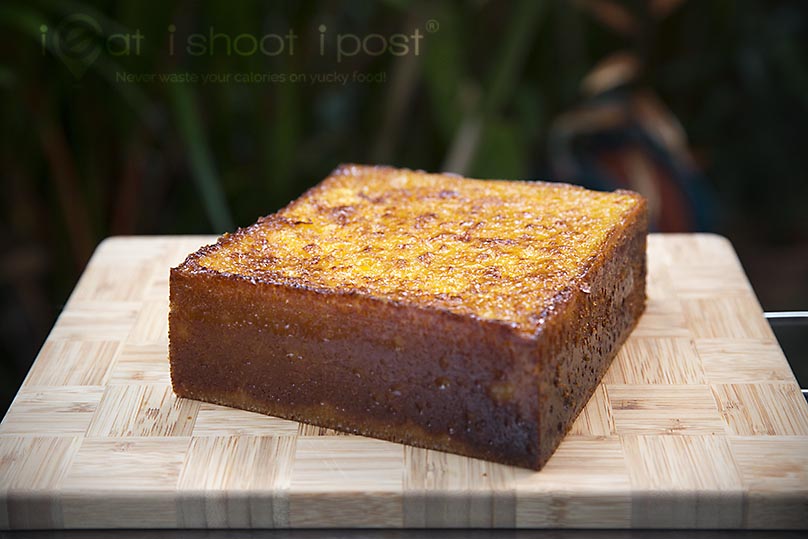
First, let us define success. A successful Bika Ambon means that the strands in the honeycomb structure go all the way from the bottom to the top so that you can peel it strand by strand when you eat it. That is, to me, the defining characteristic of this kuih. To be able to do this properly, not only do the strands need to stretch all the way from one end to the other, but it has to be long enough so that you can feel the satisfaction of stretching and pulling each strand off. That means that the kuih has to be at least 2 inches high. If it is too short, you won’t get the same stretchy satisfaction!
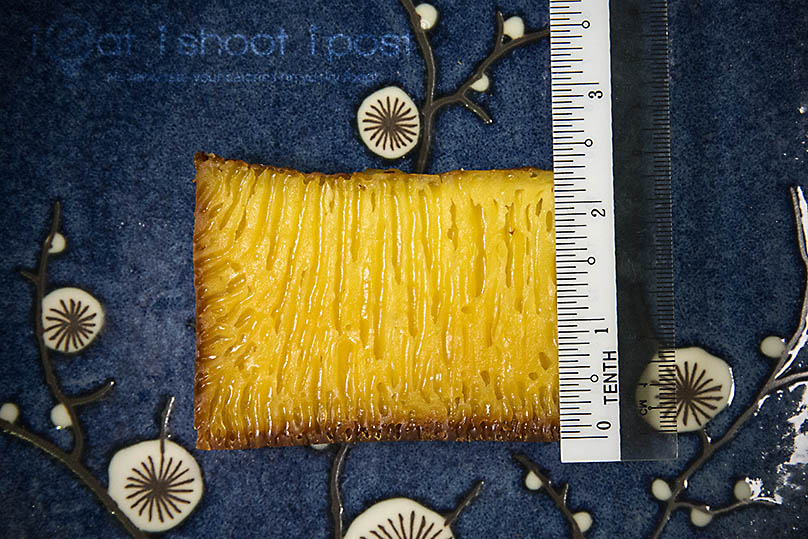
I had the great fortune of being able to taste the real thing from Medan since starting this bika ambon pilgrimage, thanks to a dear friend whose mom brought it all the way back for me. With this as the gold standard, I would say that I have succeeded. It might not be as good as the one from Medan but it is close enough.
I must confess that after failing umpteen times, I was almost at the verge of giving up. I even went to the extent of changing my oven to one that had only bottom heating but it still wasn’t able to get the result I wanted. I had tried all sorts of hacks, like wrapping good morning towels around the baking tin, placing trays of water over the kuih, baking it on a pizza stone, covering the top with baking paper, using different brands of tapioca flour, altering the yolk to whites ratio, baking it over steam ………… after trying different permutations and combinations for 6 months, I was out of ideas. Just what does it take to bake this kuih properly? Can it ever be done successfully at home or do I really need a proper bika ambon oven to bake this?
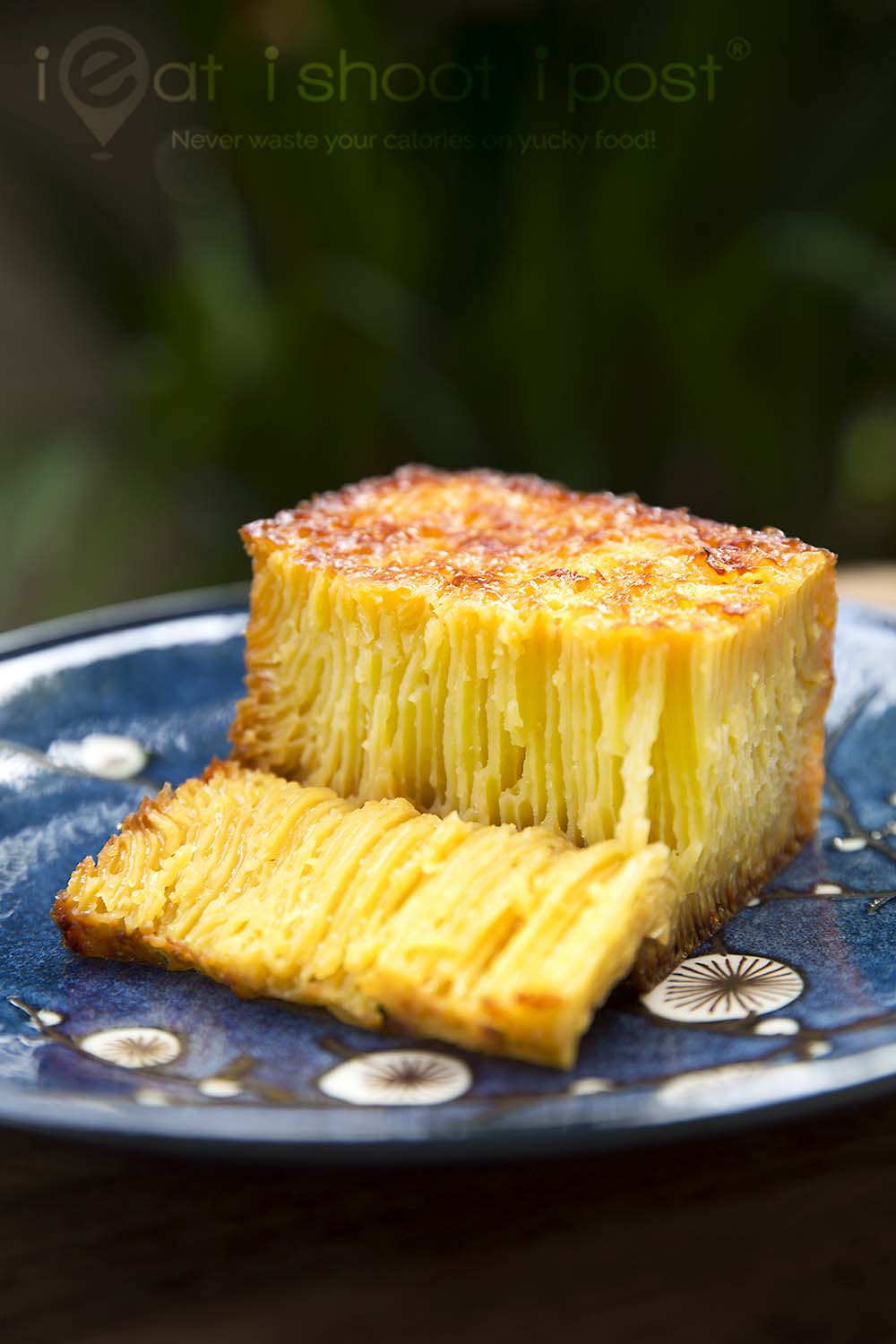
I came to the point where I was desperate enough to pray. I do pray regularly, but it had never occurred to me to specifically ask for a recipe! Well I did. Then two things happened.
Firstly I met Chef Damian at Folklore, and was blown away by his Kuih Kosui. He was kind enough to invite me to his kitchen and gave me step by step instructions on how to make Kuih Kosui (my next project). Then we began talking about Bika Ambon and things started to fall into place.
Up till then I had already worked out some basic principles of baking the kuih, based on my own failures and observations. Chef Damian helped to confirm my working hypothesis on how the kuih should be baked and how the batter should be handled. For example, I had come to the conclusion that some egg white was essential in the recipe but a lot of the recipes I have come across use only egg yolks! Chef confirmed that a bit of egg white was important for a good structure. That helped me to fix that variable so that I don’t need to experiment with an all yolk recipe. Then he also told me that in the old days, Bika Ambon was baked in old Jacob biscuit tins over a charcoal fire. That got me to change to a square tin and eschew the oven altogether and bake it on my BBQ grill!
The second thing that happen was nothing short of a miracle. I had been using a basic recipe which used 8 yolks. After a few experiments, I changed to a combination of 3 yolks and 3 whole eggs. The extra 3 egg whites gave the kuih a better texture. Because the batter takes a few hours to ferment, I sometimes ask Mylene to make it for me so that I can bake it when I come home in the afternoon. She misread my recipe and instead of either 8 yolks or 3 yolks and 3 whole eggs, she read it as 8 yolks plus 3 yolks and 3 whites! I only found out the mistake the day after my first successful bake! You can call it fortunate mistake but to me, I felt God saying: “Son, here is the recipe you asked for!”
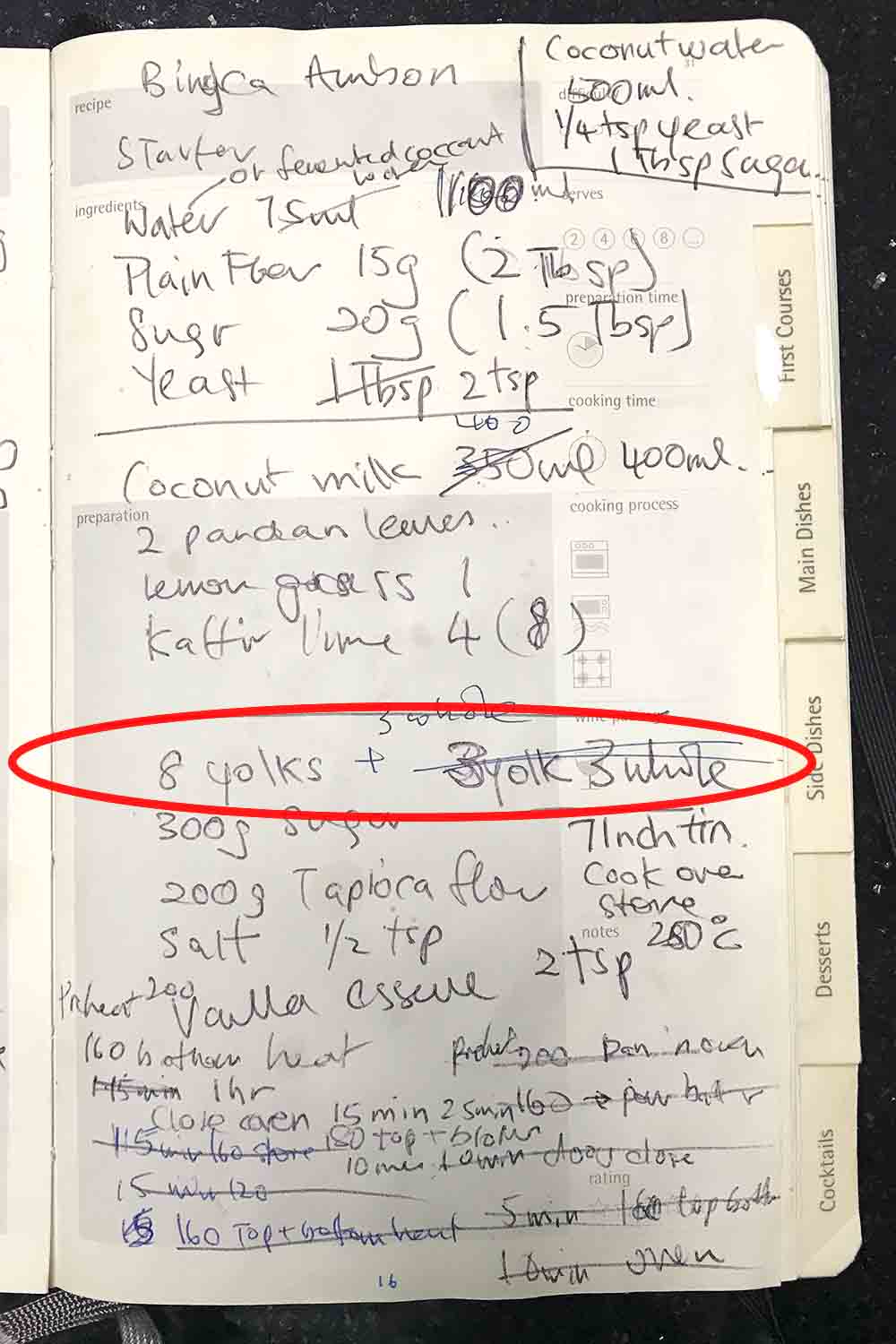
So, after almost half a year of experiments, I am pleased to share with you everything I have learnt in this baking journey. My advise to you is to follow the recipe exactly the first time round. Once you have succeeded, then go and try tweaking the recipe. Things like the shape and size of the baking tin is important. The baking tin costs less than $10, so rather than trying to tweak the recipe to fit your existing tin, just go out and buy the exact one that I use. Trust me, it will save you a lot of heartache as well as chicken eggs.
Leslie’s Bika Ambon Recipe
Ingredients
Group A
Water 100ml
Instant yeast 2 tsp
Sugar 1.5 Tbsp
Plain flour 2 Tbsp
Group B
Coconut milk 500ml (400ml after cooking)
Pandan Leaves 3
Kaffir Lime Leaves 4 stalks (double leaf)
Lemongrass 1 stalk
Vanilla 2 tsp
Salt 1/4 tsp
Sugar 300g
Group C
Egg yolks 8 (65g eggs)
Whole eggs 3 (65g eggs)
Tapioca Flour 200g
Method
1. Mix all the ingredients in Group A together and leave to ferment for 15mins. It should be foamy or else you need to buy some new yeast.
2. Using a pair of scissors, cut up the lemongrass, lime leaves and pandan leaves and add the rest of the ingredients in Group B in pot. Slowly heat it up, stirring constantly till it is almost simmering. Turn off the heat and leave to infuse for 15mins and then stir in the sugar to dissolve. Leave it to cool. After sieving you should be left with around 400mls of coconut milk.
3. Separate the eggs and place in mixing bowl. Using a spatula, stir the eggs to mix. Don’t beat as we don’t want to thicken the batter. Add the tapioca flour and all the ingredients in Gp A and B into one bowl and stir to mix. Do not use a whisk or egg beater to mix.
4. Pour the mixture through a sieve and leave to ferment for 5 hours. (I have done it in 3 hours but the extra time means more flavour).
5. Prepare the baking tin by making a paste from flour and water and use it to seal the seams in case your baking tin leaks.
6. Heat up the tin and when it is hot, spray or brush with oil. This will help to render it non-stick. Leave to cool.
7. Stir the batter and leave it for 10 – 15mins for the foam to settle. Pour through a sieve into the baking tin.
8. Skim off the foam and then bake on a 1cm high rack in a heavy stainless steel bottom pot at medium to high heat at 230°C-250°C for 1.25 – 1.5 hours or until the top of the cake has solidified. You should see bubbles appearing on top around 15 – 20 mins into the baking. If not you will need to turn up the heat. Remove from heat once all the bubbles on top have burst and the top of the cake is firm and full of pock marks.
9. Place in oven at 200°C for 5 mins to brown the top.
10. Leave to cool completely before de-panning!
IMPORTANT NOTES
According to many kuih experts this is one of the most difficult kuihs to get right, so it is important to follow all the instructions closely. Do read through these notes carefully and note every detail as it will save you a lot of heartache.

The first step is to make the starter. Traditionally, this kuih is made with a fermented palm wine aka tuak which contains the yeast that produces bubbles in the batter. But this is difficult to get, so we are using ordinary bread yeast. Just add all the ingredients in Gp A together in room temperature water and give it a good stir. After 15mins, you should see it foaming. If not, it means your yeast is too old and you need to buy fresh ones.

In order to make the kuih more authentic, I have tried fermenting coconut water overnight and using it in place of water in Gp A. It is easy to do. Just put 500ml of coconut water in a jar and add 1 Tbsp sugar and 1/4 tsp instant yeast. Cover with cloth and leave it on the kitchen counter for 24 hours. After that, you can leave it in the fridge for a few days. When you are ready to bake, measure out 100ml of the liquid and use it in place of water in Gp A. It does give the kuih a nice subtle fragrance but it isn’t spectacular. So, if you have time and are trying to impress your future mother-in-law, you could do it so that you have something else to brag about. I am still trying to get my hands on some real toddy to see what difference it will make to the kuih!

Prepare the coconut milk by cutting up the lemongrass, kaffir lime leaves and pandan leaves and adding it all in a pot. Heat up the coconut milk, stir constantly but don’t allow it to come to a boil or the milk might separate. Freshly squeezed coconut milk is the best, of course, but if you can’t get your hands on that, then the fresh coconut milk sold in packets in the fridge section of the supermarket is your next best choice. If you are using UHT coconut milk make sure you get those without thickeners added. Kara is widely available but it has carrageenan added to stabilize it and this will thicken the batter and affect the rise. It still works but I prefer the ones from Thailand which have 100% coconut milk written on the packets. Heat and stir the coconut milk until you can smell the floral aroma of the leaves. Leave it to infuse for 15 mins before adding the sugar. Stir to dissolve and leave it to cool then sieve. You should be left with around 400ml of coconut milk.
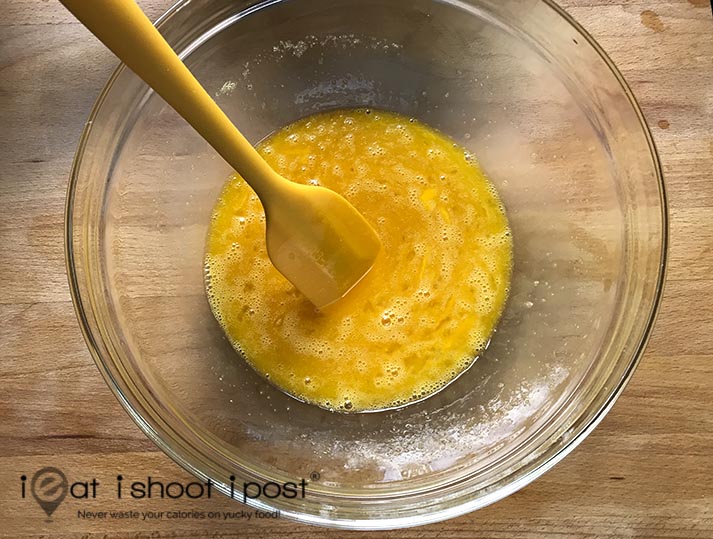
Eggs are a big part of the recipe and it is important you get eggs of the right size. In this recipe, I used Seng Choon’s carrot eggs which are 640g for a tray of 10. If you use small, 55g eggs, then your kuih will not look the same as mine and the texture will be different as well.
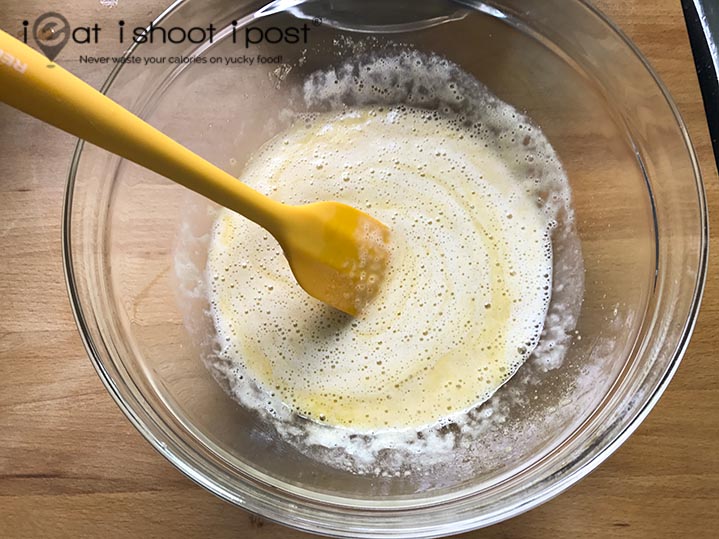
The key is NOT to whip the eggs as you don’t want to thicken the batter. The runnier the batter, the finer the strands will be. I have tried using recipes with no egg whites but I found that the structure was not strong enough and the rise was not as good. In the end, through a fortunate mistake, I struck on the 11 yolks and 3 whites ratio which gave me the perfect combination of rise and tenderness.
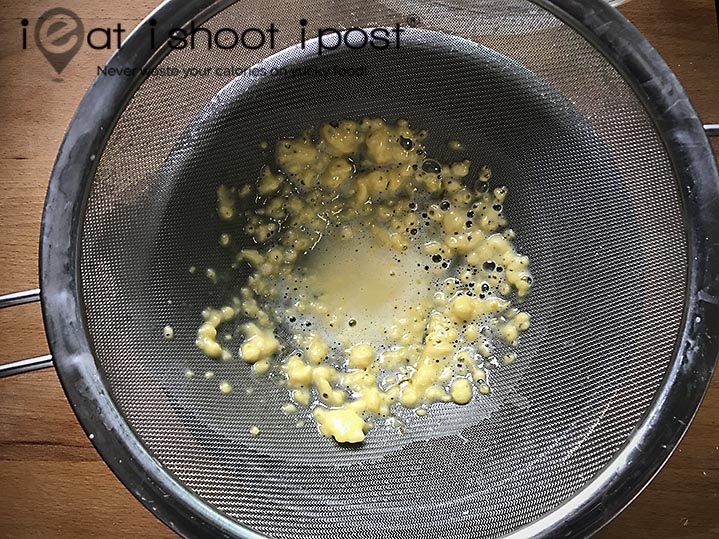
Just stir the eggs till the whites are broken up and add the rest of the ingredients then sieve the batter to make sure the whites and the tapioca flour are well mixed.
I sort of worked this bit out when I saw an online video of a lady mixing the batter by hand in a big plastic tub in a village somewhere. Then it occurred to me that this cake is supposed to be simple and made with the most basic equipment. Essentially, when you beat with your hands, you don’t incorporate air into the batter like what you would with a electric egg beater which I had been using for my previous attempts. What you want is a batter that is dark yellow rather than pale yellow in colour.
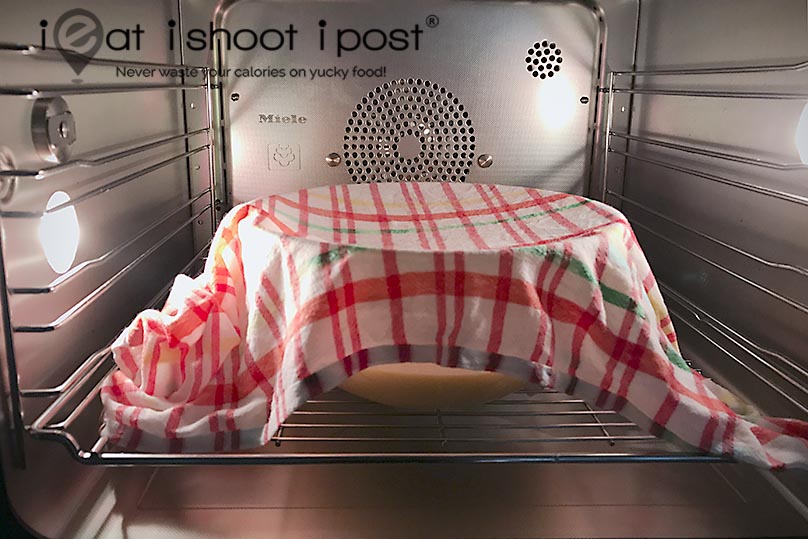
Fermentation adds flavour as well as produces the tiny bubbles required for the batter to form the tunnels in the kuih. I think 3 hours is the minimum and 8 hours is about the longest you would want to leave it. If it ferments too long the flavour will become too strong for some people. 5 hours is my preferred time. (based on the ambient room temperature in Singapore)
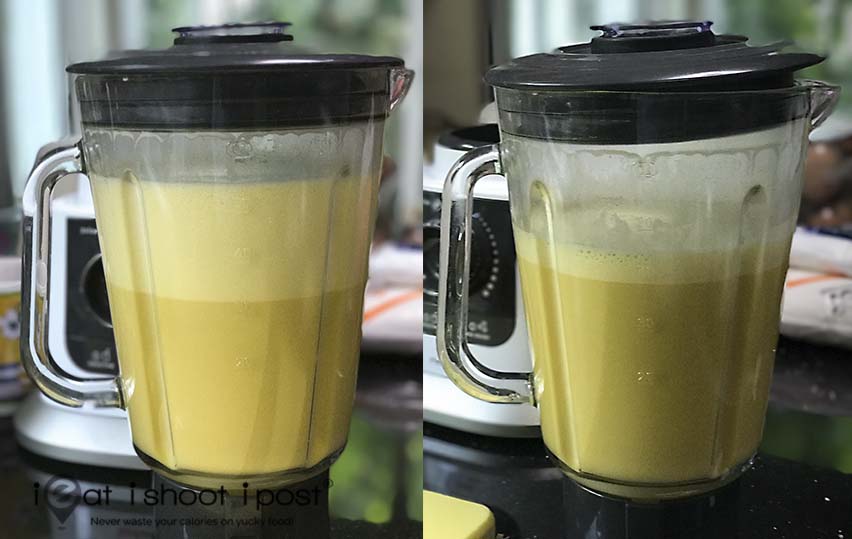
After mixing the batter in the mixing bowl for all my previous attempts, I finally worked out that a blender is the perfect equipment for mixing the batter. Just throw everything into the blender and blend it at low speed till everything is mixed and leave to ferment. About 15 mins before you want to start baking, give it a few pulses to mix the batter and allow to rest so that the foam rises to the top and then pour through a sieve into your baking tin.
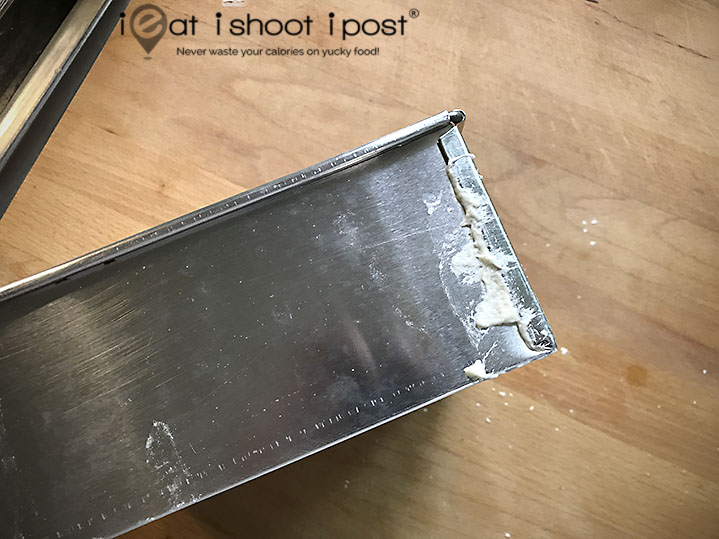
The bake the kuih, you will need a 7x7x3 in baking tin. This should cost less than $10 at the bakery supply store. Don’t use those black, non-stick tins as the bottom of the cake will tend to burn. Don’t use a round baking tin as you want the cakes to be in nice oblong slices so that you can tear the strands from top to bottom from one end of the kuih to the other. Just go get one of these 7x7x3in aluminum tins, ok?
You might need to leak proof your tins before use. Just fill it up with water and see if they leak. (most of them will). If it does, make a paste with flour and water and use it to seal the seams before you add the batter.
Before adding the batter, you need to render the tin non-stick. To do this, heat the tin over the fire till it is hot, then spray or brush some oil onto the bottom and sides. It has to be heated up as it opens up the pores in the metal which the oil will seep into to render it non-stick.
Do not use baking paper as they tend to float up and destroy the nice honeycomb pattern. Yes, they do, even if you oil the tin before placing the baking paper. DON’T do it! It destroyed my kuih a few times already, so unless you are a masochist, don’t use baking paper! Just DON’T do it!
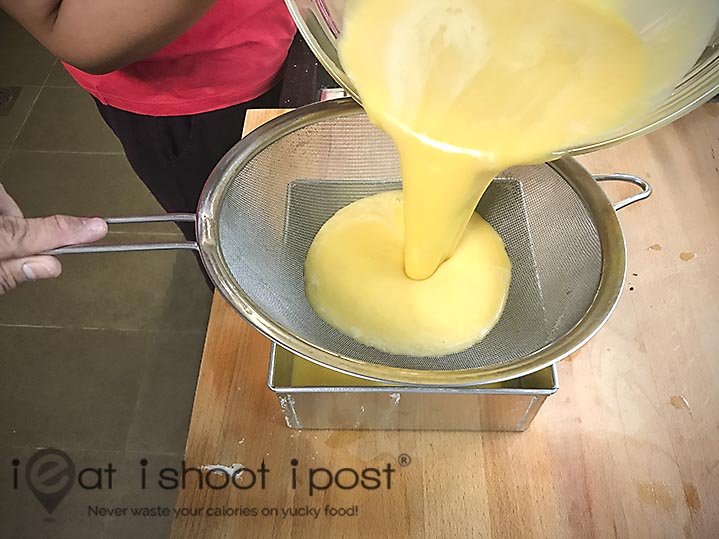
After the fermentation stage, give your batter a gentle stir so that all the tapioca flour at the bottom is well mixed. Don’t whip or introduce more air into the batter. Allow the batter to settle for 10-15 mins or till you see the batter turning back to dark yellow and a layer of foam settles. You can give the mixing bowl a few sharp taps on the table top to burst the bubbles and get the foam to settle. Pour the batter through a sieve discarding any foam trapped in the sieve.
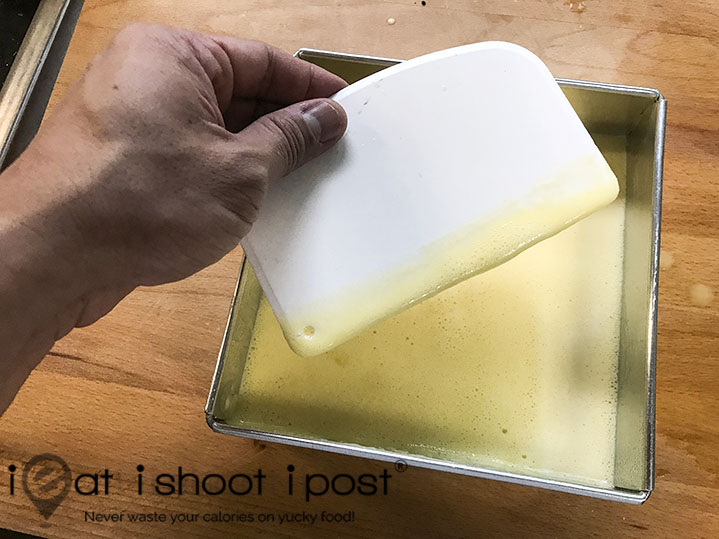
Next you will need to skim off the foam. This layer of foam, if not removed will become a dense layer on top of the kueh. This has been a problem from day 1 but I did not realize it until recently.
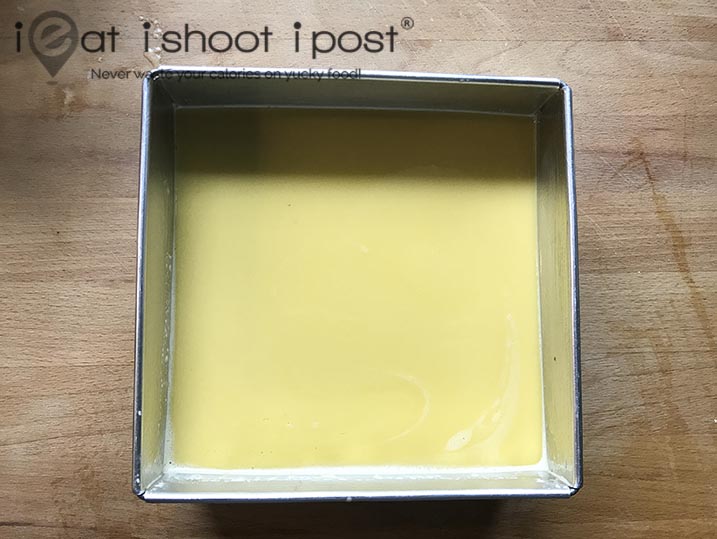
After skimming off the foam on the top, you will be left with a nice yellow batter IF you followed my instructions about not whipping air into the eggs. This is how you want it to look like just prior to baking. More foam will form during the baking process but that is fine.
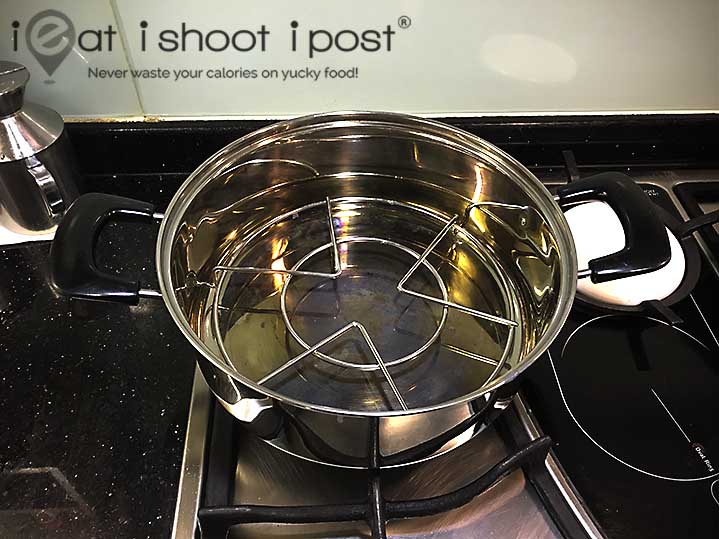
How I wish someone had just told me categorically to forget about using the oven to bake this cake from day 1! That would have saved me countless heartaches and sleepless nights! Many people say that this kuih is the most difficult to do. But, it is in fact, very simple and uses only very basic equipment. All you really need is a shallow heavy bottom stainless steel pot, a baking tin, a rack, a stove and you will be able to make this kuih with great success!
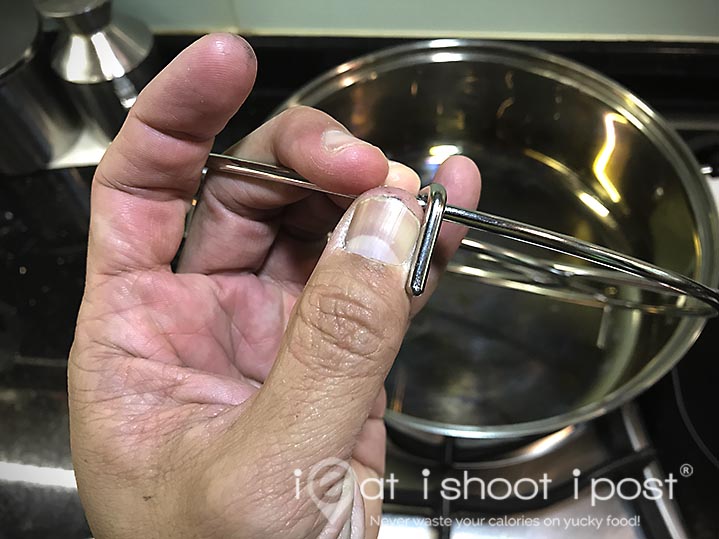
The basic principle is this. The batter must be runny and the heat must only be applied from the bottom so that the bubbles will form and rise to the top creating a nice long track. The top of the cake must remain below 65°C or else the egg will start to thicken on top and form a thick dense layer which will stop the bubbles from rising to the top. This is the commonest problem with many home made kuih ambon.
When you try to cook this in the oven, the heat will usually circulate even if you use just bottom heat and open the oven to let the heat escape. The sides of the cake will also start cooking first, so that the sides don’t rise as much as the middle, causing the kuih to dome. I tried to get around this by doing all sorts of things, like wrappthe baking tin with a towel and foil to insulate the sides and a tray of water on top. I even went to the extent of changing my oven to one with only bottom heat! But it still did not work! So let me say this categorically, DON’T use the oven, use the STOVE!
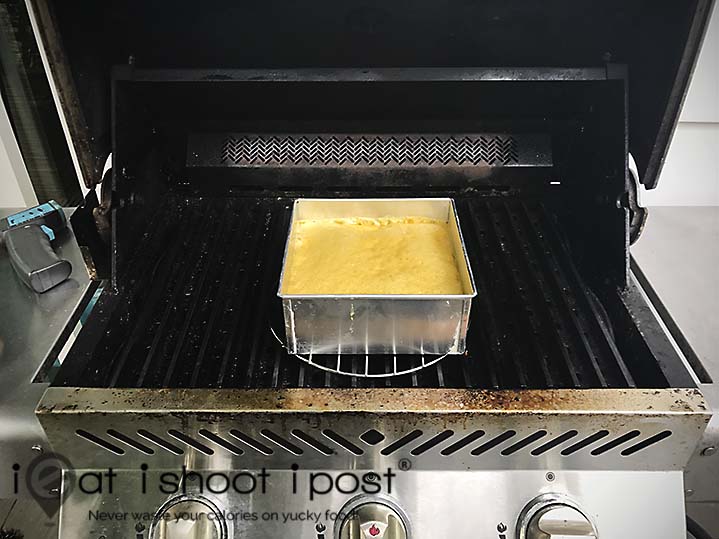
My breakthrough came when Chef Damian told me that the cake was traditionally cooked in an old Jacob biscuit tin over a charcoal fire! That got me thinking of starting a charcoal fire! (I was desperate enough by that stage) Then it occurred to me that rather than cooking over charcoal maybe I can cook it in my gas BBQ! That was my moment of epiphany, the climax in the kung fu movie when the vision of sifu appears just before the enemy strikes the final deathblow!
After two successful bakes on the gas BBQ, I decided to try it over the stove because I wanted a recipe that everybody can use. My hypothesis was that since the kuih requires infrared heat from the bottom to bake, this can be simulated by heating a stainless steel bottom pot! I had seen someone do it online before, but I wasn’t convinced. But, lo and behold, it worked! And it actually worked better than the gas grill!
What you will need is a shallow stainless steel pot that is at least 26cm in diameter. Why 26cm? Because your 7×7 in tin has a diagonal length of 25cm, so it will fit nicely into the pot. (That is why you should not use your existing 8x8in tin because you will then need a 29cm pot which is huge!).
I repeat, go buy a 7x7x3 square baking tin!
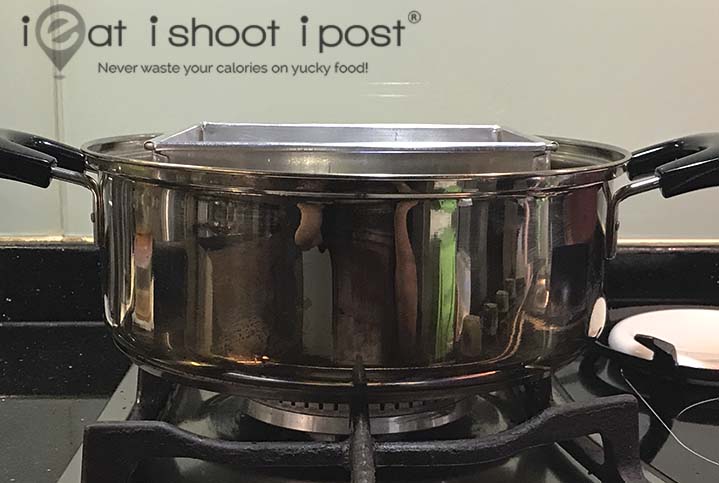
You will also need a rack that will elevate the tin about 1 cm above the bottom of the pot. It will be best if you get a heavy bottom pot as you will be heating the pot to a temperature of 230-250°C for over an hour and you don’t want it to warp. These pots are not designed to be used in this manner, so it’s best to use an old pot which you don’t mind throwing away. It must also be shallow enough so that the rim of your baking tin is ABOVE the rim of the pot. If your pot is too tall, the heat will build up above the kuih and it will cook too early, resulting in the same dense layer that you get when you bake it in the oven.
Don’t use a non-stick pan as the non-stick material may melt. Don’t use a cast iron pan as you will destroy the non stick surface and you will have to re-season the pan again. (Guess how I know?) If you have an electric stove, you can try to put a rack directly over the heating element (legs around the heating element, not in direct contact) and placing your tin on the rack. I haven’t tried it but in principle, it should work. I tried using an induction cooker to heat up the pot but it didn’t work. I think somehow my induction cooker will not continue to heat up the pot unless there is something in it.

You will need to heat the bottom of the pot till the temperature reaches 230°C to 250°C and cook the kuih for 1 hr15min to 1 hr 30 mins. If you are using gas fire like mine, use the double ring one and turn it to about 3/4 of maximum heat. (see photo) You should see lots of bubbles on the top of the kuih by the 15 min mark. If you don’t see any bubbles, you will need to increase the heat. The kuih is ready once the bubbles at the top have all broken and it is marked with lots of holes. (see photo below)
Please keep a close eye on it when it is baking and make sure there is nothing flammable around. If the pot starts to smoke a lot, then you will have to turn off the heat. I have done this on my stove top four times already and it has been ok. I used a laser thermometer to monitor the heat and it is around 230-250°C. There is a chance that the pot might might burst into flames especially if there is some oil around, so do make sure you keep an eye on it. If you walk away and forget all about it then you might have a fire to deal with! Make sure you have a fire extinguisher or fire blanket handy!
PLEASE KEEP AN EYE ON IT! ieatishootipost will not be liable for any mishaps that happen in your kitchen. You bake this kuih at your own risk!
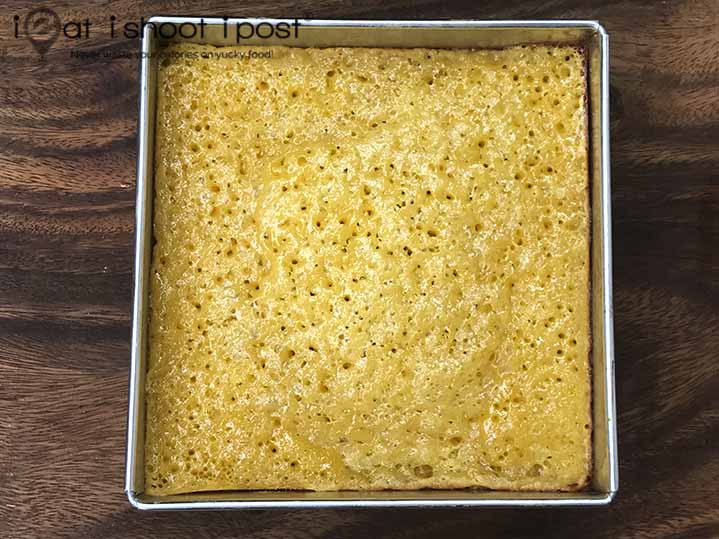
The cake is ready when all the bubbles on the top have burst and the top of the kuih is dotted with pock marks. Now remove it and place in the oven at 200°C for 5 mins or until the top turns golden brown. If you don’t have an oven, you can simply place the pot over the tray for a few minutes. The browning may not be as even, but it will work. You can even serve it as it is. It just doesn’t look as good but it will taste fine!

Once the kuih is done, leave it to cool completely before de-panning it. I know there is a great temptation to take it out and slice into it see if you got the honeycomb pattern, but if you try to remove the kuih when it is hot, you might break it as the starch is still soft. (Guess how I know?) If you are in a hurry, place the whole pan in a tray of ice water. Once the cake is completely cooled, it should be easy to remove.
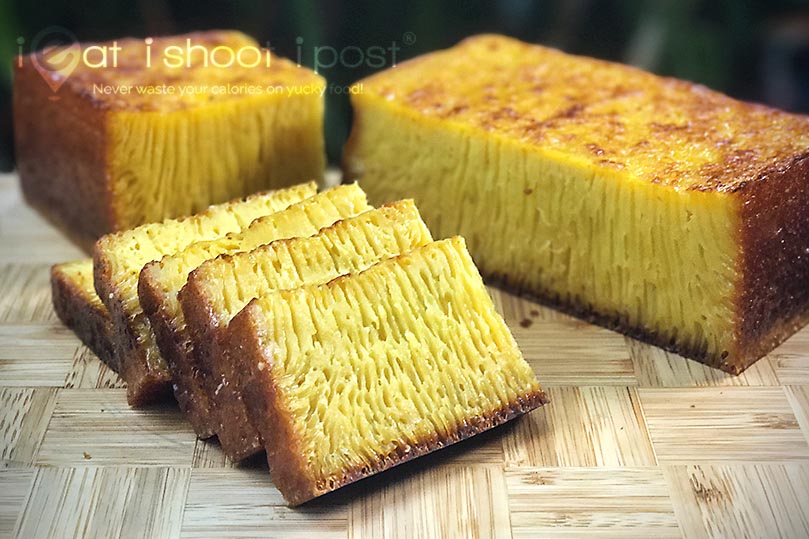
Once the cake is completely cooled, slice the cake in half and then into 1.5cm thick slices. To make cutting easier, use a wet towel to clean and moisten your knife before each slice. This is the optimum thickness as you can fully appreciate the honeycomb structure. Please tell your guest to peel off the layers and eat it instead of just taking a bite like any other cake. It took a lot of effort to get it this way, so teach them how to appreciate it.
Another reason for not cutting it too thick is because you will invariably come across people on a diet who will not even want to take a slice when they see that it is thick. Others might not even want to try, giving the excuse that they are too full or on a diet or that their goldfish had just died and they are in mourning. Make a mental note of such people and don’t ever offer them anything else because, really, how many times do you want to suffer rejection? Just “unlike” and “unfollow” them and go find yourself a group of new friends who will rejoice with you at your success, shower you with endless praise and peel away the strands of your kuih with squeals of delight! (Just kidding……. )
One last thing. You don’t really need to put this cake in the fridge if you are planning to eat it in the next day or two. But if you do, slice it first and warm it up in the microwave for 20 secs before serving. This will help soften the kuih and make it tender and chewy again.
All the best with your baking and do snap a photo of your kuih and share it with us! Here are some of my other “everything you need to know” recipes: Japanese Cheesecake, Roti Prata, Pandan Chiffon Cake, Tau Huay.
Please remember to “LIKE” and “SHARE” with everyone you know!
Read an updated bingka ambon here.
Acknowledgements
I would like to thank Chef Damien D’silva and Christopher Tan for their invaluable tips and advise!
Disclosure: Some links above are affiliate links, meaning, at no additional cost to you, we will earn a small commission if you click through and make a purchase.



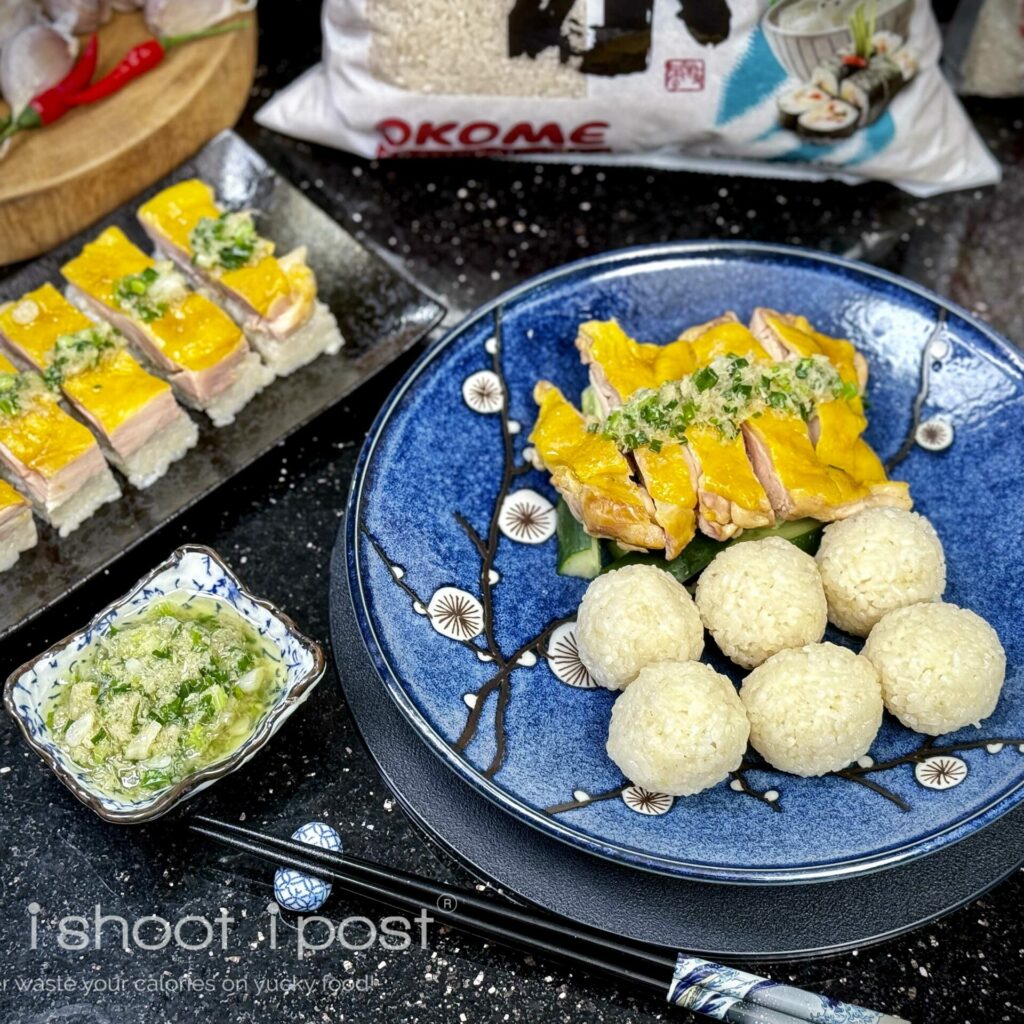

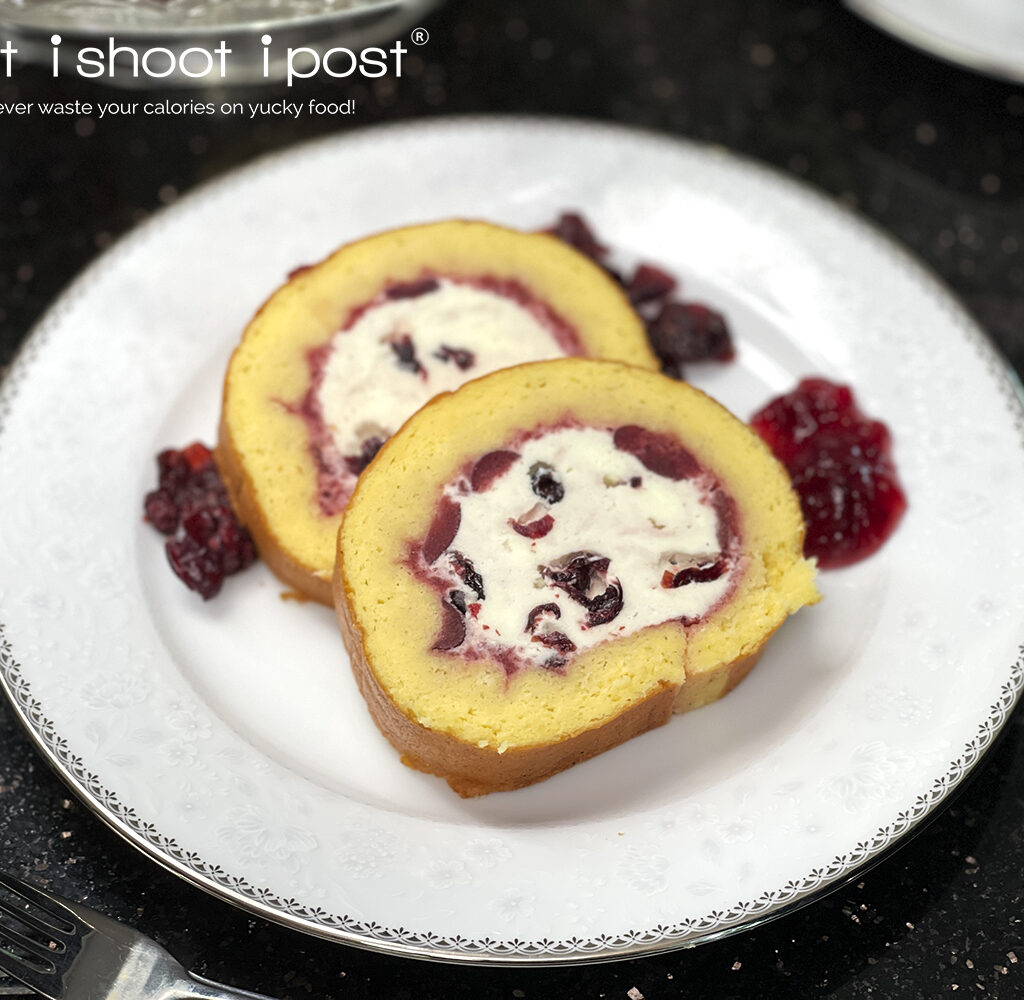
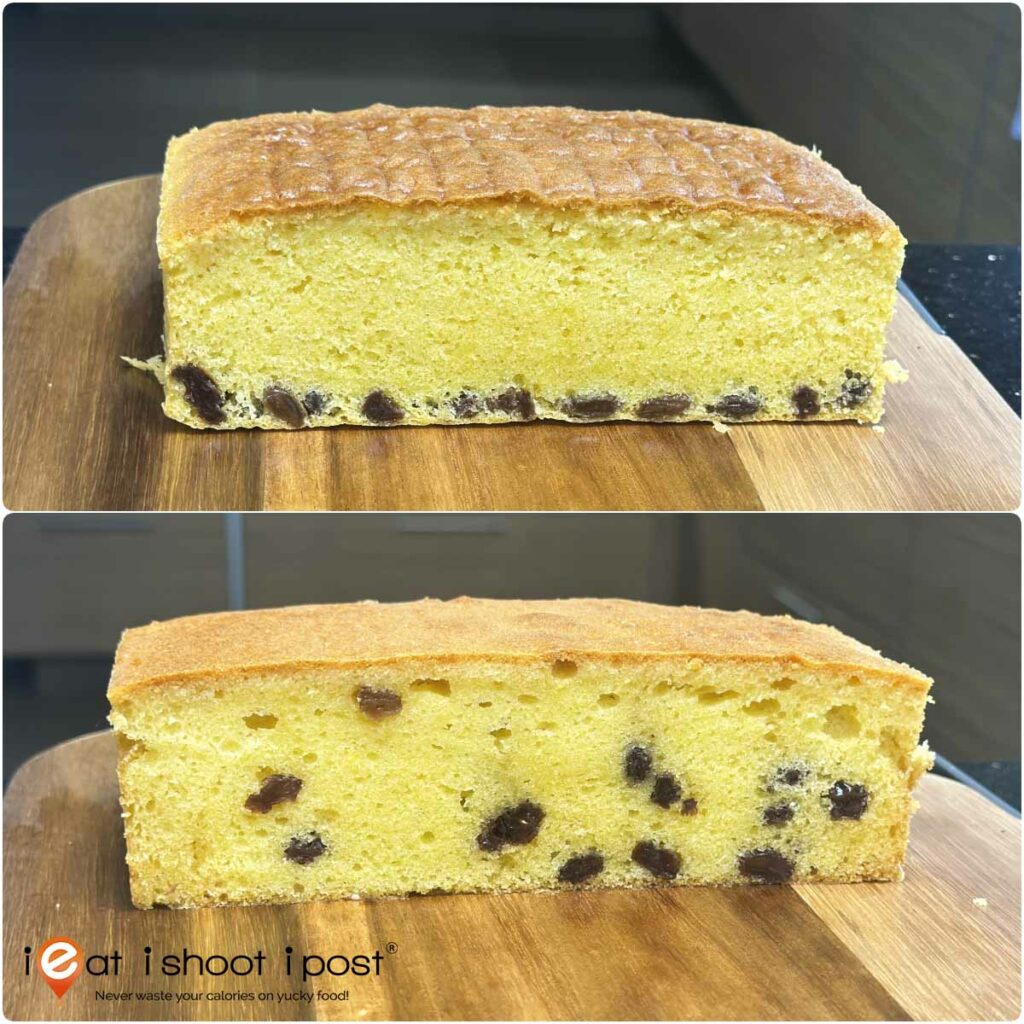
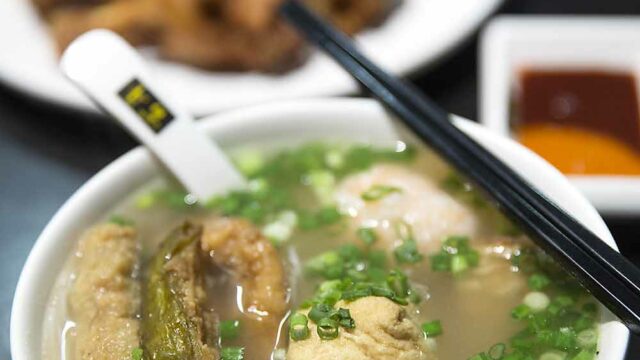
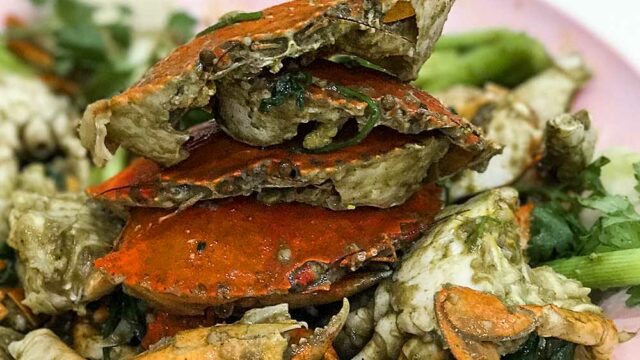
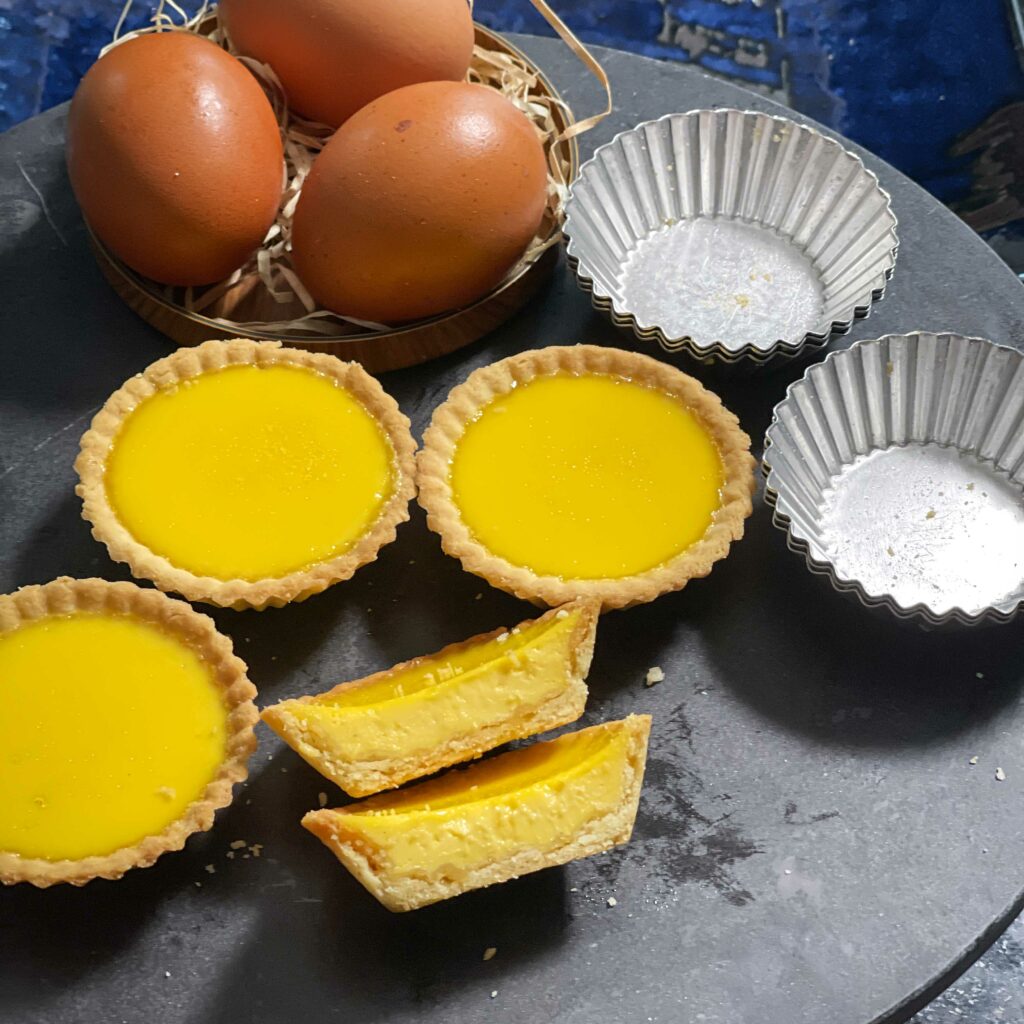



A big well done to you and thank you for your perseverance in perfecting this yummy kuih. I do have the right size pot and tin but instead of ruining(potentially) my pot, would a 30″ round hot plate(one for sizzling dishes) be good to achieve the same result?
It should work. I have done it on my cast iron pan.
Ahh thanks! It’s cheaper to replace a hot plate.
Hi Leslie,
Have a question. After reading this comment, I wasn’t so clear as to whether I still need to use the rack or not. Sounds like, not. I too don’t want to kill my pots. More than 1 hour without any water inside is definitely going to have consequences. I am not sure if using a cast iron frying pan without any liquid will have the same effect but maybe not. I have a shallow ribbed one for steaks and I have a ceramic stove-top. So I should put the square 7X7 pan on the frying pan and place the whole thing on the stove top, right? And I should not use any water, right?
Many thanks!
Hi Fran,
You can try. I usually do it on top of my BBQ so it should work. The principle is that the heat should only be applied on the bottom, not on top. Recently someone told me that she managed to do it in the oven but with the oven door open all the way. I haven’t tried it yet but it might work too.
your step 8 says to bake!?
Bake in the pot on the rack
A question about Group B, after dissolving 300g of sugar in 500ml of
coconut milk, I ended up with close to 650ml of liquid, much more than
the 400ml you have. Could it be the type of coconut milk that I’m using
(it’s from a can and it’s consistency is slightly thicker than fresh
coconut milk)? Or do I have to simmer it for longer to reduce more of
the liquid?
As long as you add the 300g sugar to 400ml of coconut milk, you will be ok.
Can I bake this directly ontop of my induction cooker without using a rack? Thks Doc.
No.
How about using the halogen lamp type if cooker?
That one you can try.
Thanks so much for this post, as I was trying to make the kuih for several times and I always failed :))). I would like to bake the kuih on my bbq gas grill instead of using the stove top. The temperature should also be around 230-250’C?
Yes, thereabouts
Thank you so much for the recipe. I tried making this today and was happy with the texture. Instead of using the gas grill, I used stew function at 200C for 1 hour with the oven door open and 150 C for 10 min with the oven door closed. During the stew function baking, I left my tray on the bottom most rack. Just to share my experience with the ardent bakers out there.
Glad you are happy with it.
Tried your recipe today, though not as perfect as yours but I’m quite happy. Will try again if time permits. Tk you for the recipe
Looks great! Can’t wait to see the cross section!
Boohoo! I dropped it as I was taking it out of the oven! There’s hole in the middle 🙁
Aiyo! But the pattern should still be ok right?
It would be good if you have a taller pan, even if it is round.
Thank you! I will need to dig around my stash 🙂
Pattern is there but not as fine as yours. Either I need to let it ferment longer (ambient temp is lower than that in non-AC Singapore), or I need to cook longer on stovetop.
Finally made it! Have not tasted this before but I was willing to give it a go! Must say it’s really delicious!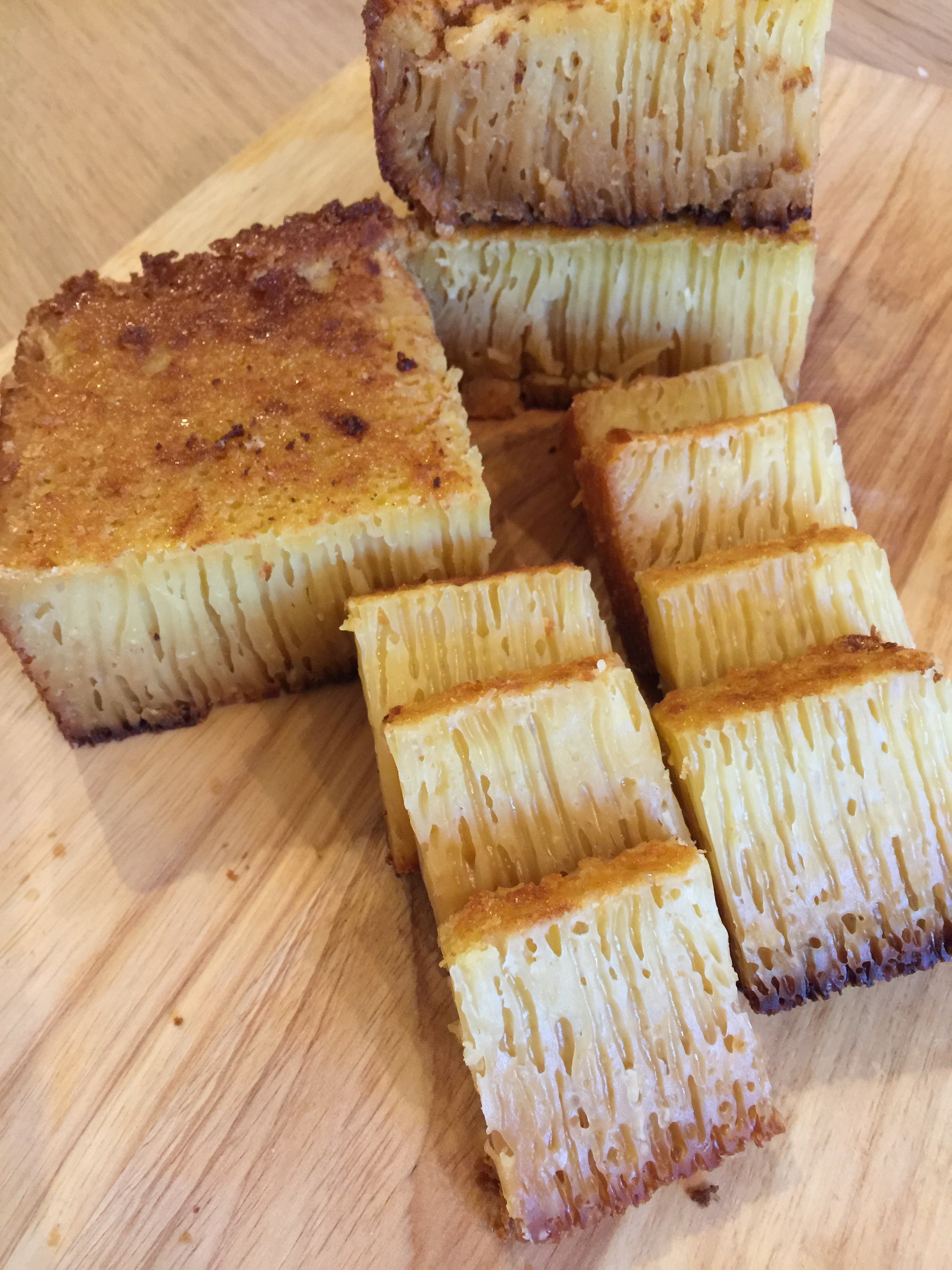
Well done!! It looks good!
Hahahah..I like your mental note..agree with it..???
amazed at how meticulous and passionate you describe this kuih. I was just told it is the Ambon kuih and surprised myself that I did not know about it. My curiousity started when I went to the Hakka parts of Kwong Tung. I thought it was a version of my Grandma’s Fat Go Gee, aka Pak Tong Go. But it is not, it felt like a rubbery chewy kuih. Then my friends told me about Ambon.
Glad you discovered Ambon!
No.
Thank you. Description on the recipe and preparation method is clear. Will try one day.
Thank you so much for this recipe. My first try and the cake turned out successfully. I added 12 kaffir lime leaves and 2 lemongrass bulbs while the rest of the ingredients remained the same. Used a pot over gas stove to bake it and watching over it quite closely, as my oven does not have a bottom heating only. The taste is good, no need to add or minus the sugar. Happiness!
That’s fabulous! Well done!
Hi Dr Leslie, can I know what yeast did you used. Mine just does not foam. I’m using bake king’s instant yeast.
Hi Xin Li, I bought mine from Redman. Bake King instant yeast should work!
If I want to use the oven to bake instead can I know the temperature and the baking tint pls
Doesn’t work, don’t waste your time and effort.
Hi Dr. Leslie, thank you for the wonderful detailed instructions and for your hard work! Would you know whether substituting cassava flour for tapioca starch might still work? I’m curious about the whether using cassava flour for this kuih would help amplify its cassava flavor, since tapioca comes from cassava anyway. Looking forward to hearing your thoughts, and thank you.
I haven’t tried so I don’t really know.
May I ask how long should I bake it if I do it over charcoal ? & followed to brown it on the oven ?
I haven’t tried baking over charcoal, unfortunately!
I’m wondering if you’ve tried putting the cake tin over a grill on the gas cook top instead of a stainless steel pot, since I’m not keen on wrecking multiple pots. I also have a gas barbecue, so would that be better in the end? Thanks for your recipe. I’ve made quite a few reasonable Ambon Bika cakes in the oven, but the honeycomb has never been as impressive as yours!
Yes, in fact, that is how I do it nowadays. You just need to make sure you put it on a wire rack rather than directly on the grill itself.
Hi Leslie , could u give me advise if I’m using Tuak + yeast? How should I work on it ? Thx
Wah, I have never used Tuak so I can’t really help you.
No worries , anyway ur cake is awesome ????????
Hi Leslie,
Just to clarify,
1. the eggs yolk + whole egg, in total is 8 + 3 or just 8?
2. The heating, fine to use just gas type stove (Singapore)?
Thank you.
Gas stove is fine.
11 yolks and 3 whites
Hi Leslie,
Just to clarify on the eggs portion.
In total is 8 yolks + 3 whole eggs (11) or 8 inclusive of 3 whole eggs(8)?
Total 11 eggs needed. 11 yolks 3 whites.
Thank you, Leslie.
thanks for all these tips – they were very inspiring and useful. I ended up making the cake on a hotpot stove, as the temperature was easier to manage. I was planning on using a wok, because I don’t have a pot which allows me to heat for an hour. Coincidentally, the hotpot stove came with a 1 cm rack, which was perfect for this exercise. I used a food thermometer and placed it on the rack, so that I can know precisely the temperature used.
I cooked the cake at 200C for 20 mins., then 170C for 30-45 mins., or until the top is done. sometimes the top is still slightly wet, so I just transfer the cake to an oven to bake the top, as the bottom part is starting to get too brown and I don’t want to burn it. There are still a lot for me to experiment with, but at the moment, I am quite happy with the results. Hopefully I can make a cake which is as beautiful as yours.
Happy that you are happy! Thanks for the feedback!
Hi Leslie. may I ask how many grams of egg yolk and how many grams of egg white do you use on this recipes? even the egg I use are in different size. but I want to make sure I can use the same amount you use by weight. thank you in advance.
I used 65g eggs. I did not weight the whites and yolks separately.
Hi Leslie! I just wanted to follow up with this comment – where I live, eggs without the shell weigh around 50 g each, so there’s no way 8 yolks (17 g each) and 3 eggs would be equivalent to 65 g eggs total over here, even with the smallest available egg size. Can you confirm what the weight of a single egg for you is? Just so that I can double check how to convert the quantities you posted for my local egg size. Your recipe looks amazing and I would love to be able to try to make it!!
Hi Lisa,
I usually buy eggs that are 60-65g here.
thank you for sharing the recipe! it seems we both are crazy for bika ambon.I had also try it many many times.sadly, I haven’t succeeded yet. I always come across the same problem: the cake stay wet and totally burn at the bottom.Could you please give me some suggestion of how may I fixed this problem? I attached one of the photos of my failure cakes.
Yes, you need to set the cooking method like I describe in the post and lower the heat!
thank you so much for reply! it make sense the heat is the problem. because I don’t have gas and fire at home. I use ceramic hobs and a 1 cm tall rack on top to cook. the temperature will be different to yours. But I can definitely adjust the temperature somehow. Do you know how hot the rack should be? the one you put cake tin on.
I do have an infrared thermometer to find out about temperature. I can probably heat up the empty baking tin then point the thermometer on tin center inside to find out?
The temperature of the pot should be 230C, like the inside of an oven. But the heat is not direct, it radiates to the bottom of your baking tray that is on the rack. I have not measured this temperature.
Hi Leslie, my kids are gluten free. I’m wondering if I can replace the plain flour to activate the yeast with corn flour or other gluten free flours?
You can try. I haven’t tried before so I don’t know.
Leslie, is it true when the ambon is still hot and u cut it, the honey comb won’t form?
The honeycomb is already formed but if it is too hot, the structure may just meld together when your knife cuts through.
Bro. May I know what type of pot you are using and where to buy. I have try the smaller version of ambon kuih but does not look good. Pls. Do let me know. Tha ks
I am using a stainless steel steamboat pot.
Thank will try again
Tried your recipe today, though not as perfect as yours but I’m quite happy. Will try again if time permits. Tk you for the recipe
That looks good! I take it you want it a little thicker?
No not the thickness as I used a 8 x 8 inches baking tin thus I already know it’s going to be thinner haha. I used a ceramic stove to baked it and the heat is inconsistent so I’m trying to think of some other way to bake it 🙂